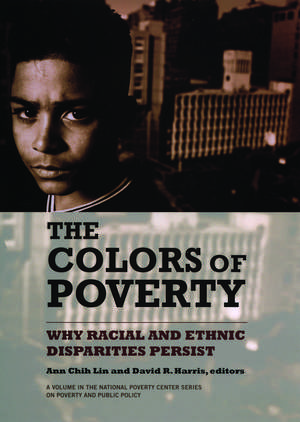The Colors of Poverty: Why Racial and Ethnic Disparities Persist: National Poverty Center Series on Poverty and Public Policy
Editat de Ann Chih Lin, David R. Harrisen Limba Engleză Paperback – 31 aug 2010
Given the increasing diversity of the nation—particularly with respect to its growing Hispanic and Asian populations—why does racial and ethnic difference so often lead to disadvantage? In The Colors of Poverty, a multidisciplinary group of experts provides a breakthrough analysis of the complex mechanisms that connect poverty and race. The Colors of Poverty reframes the debate over the causes of minority poverty by emphasizing the cumulative effects of disadvantage in perpetuating poverty across generations. The contributors consider a kaleidoscope of factors that contribute to widening racial gaps, including education, racial discrimination, social capital, immigration, and incarceration. Michèle Lamont and Mario Small grapple with the theoretical ambiguities of existing cultural explanations for poverty disparities. They argue that culture and structure are not competing explanations for poverty, but rather collaborate to produce disparities. Looking at how attitudes and beliefs exacerbate racial stratification, social psychologist Heather Bullock links the rise of inequality in the United States to an increase in public tolerance for disparity. She suggests that the American ethos of rugged individualism and meritocracy erodes support for antipoverty programs and reinforces the belief that people are responsible for their own poverty. Sociologists Darren Wheelock and Christopher Uggen focus on the collateral consequences of incarceration in exacerbating racial disparities and are the first to propose a link between legislation that blocks former drug felons from obtaining federal aid for higher education and the black/white educational attainment gap. Joe Soss and Sanford Schram argue that the increasingly decentralized and discretionary nature of state welfare programs allows for different treatment of racial groups, even when such policies are touted as "race-neutral." They find that states with more blacks and Hispanics on welfare rolls are consistently more likely to impose lifetime limits, caps on benefits for mothers with children, and stricter sanctions. The Colors of Poverty is a comprehensive and evocative introduction to the dynamics of race and inequality. The research in this landmark volume moves scholarship on inequality beyond a simple black-white paradigm, beyond the search for a single cause of poverty, and beyond the promise of one "magic bullet" solution. A Volume in the National Poverty Center Series on Poverty and Public Policy
Preț: 256.92 lei
Nou
Puncte Express: 385
Preț estimativ în valută:
49.16€ • 51.47$ • 40.68£
49.16€ • 51.47$ • 40.68£
Carte indisponibilă temporar
Doresc să fiu notificat când acest titlu va fi disponibil:
Se trimite...
Preluare comenzi: 021 569.72.76
Specificații
ISBN-13: 9780871545404
ISBN-10: 0871545403
Pagini: 341
Dimensiuni: 168 x 235 x 23 mm
Greutate: 0.59 kg
Editura: Russell Sage Foundation
Colecția Russell Sage Foundation
Seria National Poverty Center Series on Poverty and Public Policy
ISBN-10: 0871545403
Pagini: 341
Dimensiuni: 168 x 235 x 23 mm
Greutate: 0.59 kg
Editura: Russell Sage Foundation
Colecția Russell Sage Foundation
Seria National Poverty Center Series on Poverty and Public Policy
Notă biografică
ANN CHIH LIN is associate professor in the Gerald R. Ford School of Public Policy and Department of Political Science at the University of Michigan. DAVID R. HARRIS is professor of sociology and deputy provost at Cornell University. CONTRIBUTORS: Scott W. Allard, Heather E. Bullock, George Farkas, David R. Harris, Michèle Lamont, Ann Chih Lin, Selina A. Mohammed, Devah Pager, Lincoln Quillian, Rozlyn Reed, Sanford F. Schram, Mario Luis Small, Joe Soss, Michael A. Stoll, Christopher Uggen, Darren Wheelock, and David R. Williams
Cuprins
Chapter 1: ¿Why is American Poverty Still Colored in the 21st Century?" Ann Chih Lin and David R. Harris. Part I Mechanisms that Connect Group Identity to Group Outcomes Chapter 2: "The Dynamics of Discrimination," Devah Pager. Chapter 3: "Justifying Inequality: A Social Psychological Analysis of Beliefs about Poverty and the Poor," Heather Bullock. Chapter 4: "How Culture Matters for the Understanding of Poverty: Enriching Our Understanding," Michele Lamont and Mario Small. Part I INonracial Explanations for Racial Disparities in Poverty Chapter 5: "How Educational Inequality Develops," George Farkas. Chapter 6: "Poverty, Migration, and Health," David R. Williams and Selina A. Mohammed. Chapter 7: "Can Social Capital Explain Persistent Racial Poverty Gaps?" Lincoln Quillian and Rozlyn Redd. Part III Policy, Race, and Poverty: Intentions and Consequences Chapter 8: "Race, Place, and Poverty Revisited," Michael A. Stoll. Chapter 9: ¿Getting There or Losing Out: Place, Race, and Access to the Safety Net,¿ Scott W. Allard. Chapter 10: "Punishment, Crime, and Poverty: The Impact of Criminal Sanctions on Racial, Ethnic, and Socioeconomic Inequality," Darren Wheelock and Christopher Uggen. Chapter 11: "Coloring the Terms of Membership: Reinventing the Divided Citizenry in an Age of Neoliberal Paternalism," Joe Soss and Sanford F. Schram.




